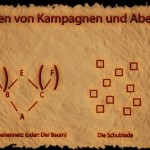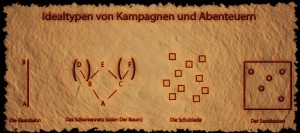 D6ideas is mainly focused on Gaming Content like you can read above. This means content which is meant to be used in a Game. Thus the whole coverage of theoretics or meta-game is not really touched here. Suits me normally!
D6ideas is mainly focused on Gaming Content like you can read above. This means content which is meant to be used in a Game. Thus the whole coverage of theoretics or meta-game is not really touched here. Suits me normally!
There is however a loophole! the Editorials. They are well suited for this “general” Knowledge stuff. Which is why I will talk about such that.
What I am talking about this time is types of campaign or adventure design and after that two related books I wanted to recommend.
Those of you who read in discussion boards have probably already heard of most of this. Still let’s start in the beginning. There are two extreme examples for these types.
At first we have the well known and “loved” Railroad of the linear adventures. There is a predefined start, followed by a already chosen intermediate stations respectively scenes and after that we reach the end of the adventure. There is either only little or pretended degree of interaction. Instead there is (hopefully) well wrought dramaturgy and an overall nice story which is way more difficult in other ideal types. Being a really good GM here means to tell that good stories nobody minds being “robed” of their choice. Of course the other solution is to pretend that their choices matter that well, that they don’t notice (just mind that if the players ever catch up you might me in trouble).
At the other end of the spectrum is the Sandbox. Here there is no adventure design whatsoever but a really sophisticated setting design instead. The point here is to design a scenario in which every NPC is premade with his own motivations, goals and quirks as well as with his own set of allies and enemies. The resulting network is complicated enough to write its own stories. Scenes and whole adventures just develop out of the actions of the various characters (be they PC or not). Of course the GM has only little influence over the arc of suspense or adapting the adventure to the SC levels. Still the resulting stories are mostly way more convincing and dynamic that with the railroad even if they wouldn’t make a good novel. A good GM of this type should find ways to remember all of their NPCs completely all the time and even have a better overview over the player characters than most other types of GM. Even adapting those motivations the whole time due to the situation has to be considered. Because as soon as you forget even one NPC and his influence on the story… well it collapses like a house of cards.
Most gaming groups are somewhat in the middle of that (even most of those who claim to play linear adventures or Sandbox). But even in this seeming limbo there are ideal types. I myself can point out at least two of those.
On the left we have the Tree or the Rail Network. The main building blocks here are neither the adventure itself nor the NPCs but the scenes (well in the other type I’ll show you the scenes are also the core.. just compare it to the above mentioned type 🙂 ). The scenes are not fully dynamic like in the Sandbox and not as static as in the Railroad. Instead they are open-ended in that they have multiple possible outcomes which lead to other scene. So something like that:
Scene A and B can lead to C which in turn can lead to D, E or F.
If you draw that as a sort of flowchart you get either to a Tree like structure (1-2 starting points which branch out into a whole bunch of possible end points) or something I like to call the Rail Network. In that we have the same beginning and the branching out but in the end all lead to the same ending point. In such it is similar to the Railroad but makes the pretended interaction way easier.
And to the right, near the Sandbox, there is the collection of scenes. Here, there are all scenes gathered which might make sense in the adventure (and which the GM thought about). As I don’t have a better name I call this the Drawer as here everything is just thrown in without organizing it. While not every scene may be used and even may be open ended or not, the GM just fishes out the one he needs right now and as such has a big help for the adventure ahead.
To help you understand my rambling how about a nice little diagram:
The alert reader might wait for me to start bitching about this or that type of game. The Railroad is stupid or the Sandbox is boring… whatever. That’s not my point though. I certainly not the first to say this but it bears repeating: None of these types is worse than the other!
It doesn’t matter if I enjoy getting told a good story (hey I designed the main character in the novel didn’t I?) – and there ARE GMs which are really good storytellers! – or if I like to act in a realistic and well designed environment. Every one of those is entertaining and can be a lot of fun, even if there are only a few players who enjoy both.
So why all this? Well for once because writing it down has helped me to organize my thought on this, and on the other hand there really are a lot of gamers who are new to this and I wanted to give them an overview about at least one of the warfare out there. And last but not least I want to recommend two really good books on adventure design.
First there is the Adventure Creation Handbook by Cherie Arbuckle and then Play Unsafe by Graham Walmsley.
None of those two is the philosopher’s stone, heck I will even go so far that I didn’t read anything new at all! Still there is a BIG difference between “well yeah I thought so” and “oohh now I know it!”. It really helped me a lot to see these concepts written down in structure and easy to understand. They converted more or less all of my gut instincts into tried and proven concepts. So even the “I know it all” GMs of you might consider buying one.
The methods of Play Unsafe are more or less best suited for the Drawer or perhaps even the Sandbox while the Adventure Creation Handbook is more for the Tree or perhaps the Drawer, too. One thing is for sure. They don’t tell you the same things. The methodical adventure writing process of Adventure Creation Handbook even directly contradicts the improvisational methods of Play Unsafe.
What the book for you might be? Choose yourself. This is why I gave you the descriptions of the types in the first place!
Okay enough preaching. You probably have scrolled down here anyway to see what the articles (6 of them by the way, after we finally started rolling our eponymous d6 for the number of articles last week) this week are going to be:
In English we have:
On Monday another page from Shadom’s d6 Atlas – this time with more of a landscape than a map for use as a handout or as an inspiration.
On Thursday we give you an npc write-up of the Blue Planet top terrorist C. A. Nada.
On Saturday two of our contributors team up to deliver Kill the Ones You Love, a short adventure summary for SLA Industries.
And for the German speakers there is:
On Monday the Atlas page appears with a German introduction.
On Thursday there is a translation of the Blue Planet article.
On Saturday we will close the week with the translation of Kill the Ones You Love.

